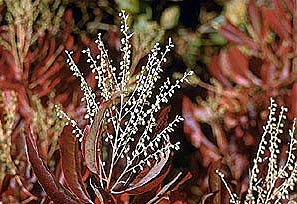Why do tree leaves change color?
Changes in leaf color in the fall are the result of biochemical processes in some types of tree and plant leaves. As the chlorophyll breaks down, the green color disappears and the yellow to orange colors produced by Carotenoids become visible. But not all leaves turn yellow, orange, or brown. What about the bright red and purple autumn leaves we see? Anthocyanins, which are found in foods such as cranberries, red apples, concord grapes, blueberries, cherries, strawberries, and plums, are also present in some tree leaves. Trees with red anthocyanins pigments are distinguishable by their development of red to purple leaves.[1]
What factors stimulate leaf color changes?
The timing of color change and leaf fall are primarily regulated by the increasing length of night and shorter days that begin in August and continue through the end of autumn. As days grow shorter and nights grow longer and cooler, biochemical processes in the leaf are stimulated and leaf color changes.[2]
What gives leaves their new palette of vibrant autumn colors?
A color palette needs pigments, and there are three pigment types involved in autumn color: chlorophyll, carotenoids, and anthocyanins. [2] Both chlorophyll and carotenoids are present in the chloroplasts of leaf cells throughout the growing season. Most anthocyanins are produced in the autumn in response to bright light and excess plant sugars within leaf cells.
Chlorophyll gives leaves their basic green color and is the driver for plant photosynthesis. During the growing season, chlorophyll is continually being produced and broken down, making leaves appear green. As night length increases in the autumn, chlorophyll production slows down and then stops. Eventually all the chlorophyll is destroyed. The carotenoids and anthocyanins that are present in the leaf are then unmasked and show their colors.
Do all types of trees change leaf color in the same way?
Tree species have identifiable fall colors. Oaks turn red, brown, or rust. Hickory tree leaves turn, golden bronze. Aspen and yellow-poplar leaves are golden yellow in the fall. Dogwood tree leaves shift to a purplish red. Beech tree leaves are a light tan. Sourwood and black tupelo leaves turn crimson. Maples are one of my favorite tree types, but their leaf color differs by species: red maple turns brilliant scarlet; sugar maple leaves become orange-red; and black maple leaves turn bright yellow.
You’ve undoubtedly noticed that not all fall leaf transitions are colorful. Striped maple leaves become almost colorless. Leaves of some species such as the elms simply shrivel up and fall, exhibiting little color other than drab brown. [2]
Why do some trees take longer to show fall leaf color?
Tree leaf color changes vary by species, regardless of latitude and elevation. Sourwood trees (Oxydendrum arboreum) shift to fall colored leaves in late summer while all other species are unchanged. [3]

Oaks transition to fall colored leaves long after other species. Differences in the timing for leaf changes appears to be species-specific and genetically based.
Why are some autumn leaf colors more spectacular in some years than others?
The display of fall leaf colors in any particular autumn season are influenced by temperature and moisture conditions present before and during the time the level of chlorophyll decreases. A succession of warm, sunny days and cool, crisp but not freezing nights seems to bring about the most spectacular color displays. The amount of moisture in the soil also affects autumn colors. Like the weather, soil moisture varies greatly from year to year. The plethora of combinations of temperature and soil moisture conditions guarantees that no two autumns will be the same.
Read more about the science behind fall leaf color changes on these websites:
U.S. Forest Service: Caring for the land and serving people
The Science of Color in Autumn Leaves – US National Arboretum
Why Do Fall Leaves Change Color? by Science Made Simple
Footnotes
[1] Why Leaves Change Color – SUNY-ESF
[2] USDA Forest Service: Why Leaves Change Color
[3] Bernheim Arboretum and Research Forest: sourwood Oxydendrum arboreum
